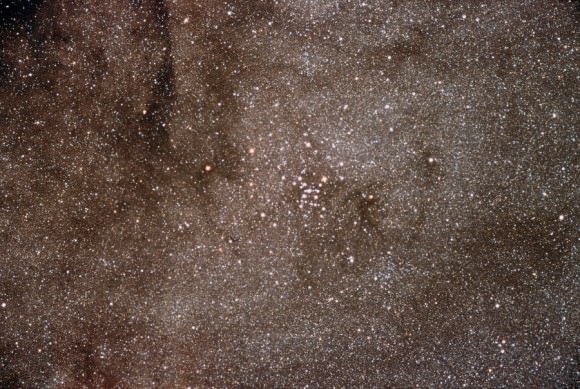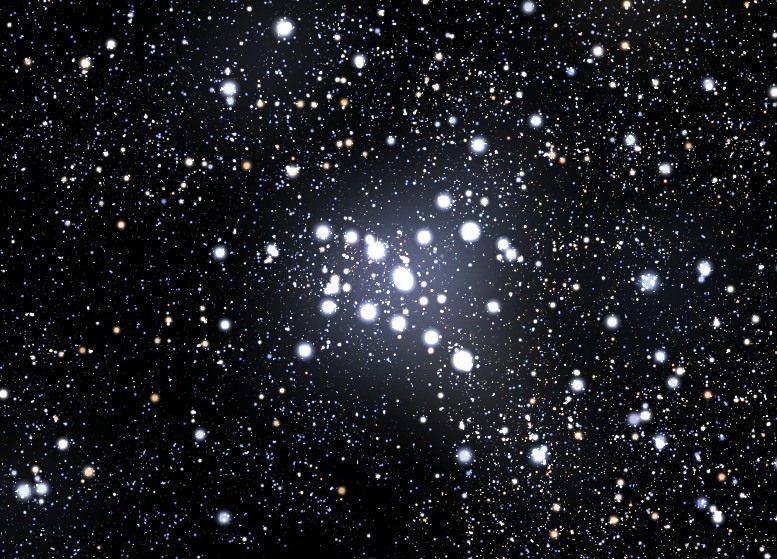Welcome to another Messier Monday. In our ongoing tribute to the great Tammy Plotner, we bring you another item from the Messier Catalog!
In the 18th century, while searching the night sky for comets, French astronomer Charles Messier kept noting the presence of fixed, diffuse objects in the night sky. In time, he would come to compile a list of approximately 100 of these objects, with the purpose of making sure that astronomers did not mistake them for comets. However, this list – known as the Messier Catalog – would go on to serve a more important function.
However, not all of the Messier Objects were first observed in the 18th century. Some, like Messier 7 cluster (aka. NGC 6475 or the Ptolemy Cluster) have been known about since classical antiquity. As the name would suggest, this open star cluster was first observed in the 2nd century CE by Greek-Egyptian astronomer Claudius Ptolemaeus (aka. Ptolemy), who described it as a nebula in 130 CE.
Description:
Located in the Scorpius constellation, this bright cluster of about 80 mixed magnitudes stars is located about 980 light years from Earth. Moving along through space in an area spanning about 25 light years across, the cluster exerts a tidal influence on an area that measures 40.1 light years across. It’s combined mass is estimated to be 735 times that of the Sun.
While this clusters stars are believed to have all been born at about the same time – some 200 million years ago – they appear to have evolved differently. Approaching us at a speed of about 14 kilometers per second, the brightest visible star is a yellow giant of spectral type G8. Messier 7 also contains four magnetic Ap/Bp stars: HD 162305, HD 162576, HD162725, and HD 320764.

History of Observation:
This great open star cluster is most often credited to Ptolemy, who listed in in his ‘Almagest’ as Object Number 567 in 130 AD. From his notes he describes it as “A nebulous cluster following the sting of Scorpius.” It was also independently recovered by Ulegh Begh and listed as 564 in his catalogs, Edmond Halley listed it as No. 29 in his catalog of southern stars of 1678 – as well as Ha II.2 by Hodierna and Lac II.14 by Lacaille.
However, we know it best by its catalog given by Charles Messier when he discovered it for himself on the night of May 23rd, 1764. As he described it at the time:
“I have determined in the same night [May 23 to 24, 1764] the position of another star cluster which is more considerable and of a larger extension: its diameter could occupy 30 arc minutes. This star cluster also appears at simple view [to the unaided eye] like a considerable nebulosity: but when examining it with a refractor, the nebulosity disappears, and one perceives nothing but a cluster of small stars, among which there is one which has more light: this cluster is little distant from the preceding; it is between the bow of Sagittarius and the tail of Scorpius. I observed in the Meridian the passage of the middle of this cluster, and compared it to the star Epsilon Sagittarii for determining its position: its right ascension was 264d 30′ 24″, & its declination 34d 40′ 34″ south.”
Locating Messier 7:
Messier 7 is one of the few Messier Objects that is easily detectable with the naked eye. Under dark conditions, it will appear as a conspicuous patch in the sky. But amateur astronomers are to take care that they not confuse it with its dimmer, northwestern neighbor, M6. One of the easiest ways to located it is to locate the two familiar constellation asterisms of Scorpius and Sagittarius in the night sky. The bright star that represents the ‘stinger’ on the tail of the Scorpion is Lambda. Aim your binoculars three finger-widths east.

With binoculars, Messier 7’s stars will appear of varied brightness with no particular pattern, and will occupy about 1/3 the field of view in average binoculars. Those using a telescope are encouraged to use the lowest magnification because of Messier 7’s large apparent size. Because it is so bright, this open cluster is a great object on a moonlit night and larger telescopes can fully resolve its members.
It’s truly a shame the Messier didn’t understand spectroscopic binaries with red-giant primaries, the link between magnetic fields and stellar evolution, element abundances in the metal-rich open clusters, or finding benchmark brown dwarfs to probe the substellar initial mass function as a function of time. But thanks to modern astronomers, when we look at Messier 7, we do!
And here are the quick facts about the Ptolemy Cluster:
Object Name: Messier 7
Alternative Designations: M7, NGC 6475, Lac II.14, The Scorpion’s Tail, Ptolemy’s Cluster
Object Type: Type “E” Open Star Cluster
Constellation: Scorpius
Right Ascension: 17 : 53.9 (h:m)
Declination: -34 : 49 (deg:m)
Distance: 0.8 (kly)
Visual Brightness: 3.3 (mag)
Apparent Dimension: 80.0 (arc min)
Good luck hunting for the Ptolemy Cluster! And remember as you gaze at it that you are looking at the same stars as one of the most famous astronomers and cosmologists that ever lived.
We have written many interesting articles about Messier Objects here at Universe Today. Here’s Tammy Plotner’s Introduction to the Messier Objects, M1 – The Crab Nebula, and David Dickison’s articles on the 2013 and 2014 Messier Marathons.
Be to sure to check out our complete Messier Catalog. And for more information, check out the SEDS Messier Database.

